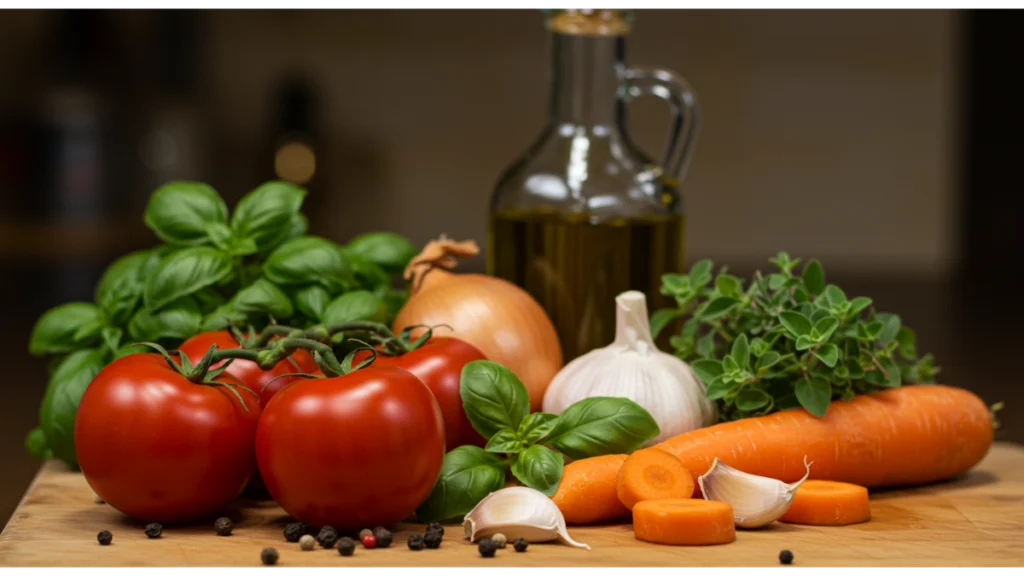
A steaming bowl of Homemade Tomato Soup has a way of brightening even the rainiest afternoon. This from-scratch version captures everything you love about the classic: ripe tomatoes simmered with aromatics, a hint of herbs, and a silky finish that warms you to your core. We’ll keep your original ingredient list exactly as provided and follow the same step order, while upgrading clarity, flow, and SEO so the post reads like a pro food blog and fits perfectly in WordPress.
Why You’ll Love This Homemade Tomato Soup
- Pure tomato flavor: Fresh, ripe tomatoes (or quality canned) shine with gentle simmering and simple herbs.
- Flexible by design: Easily make it vegan, creamy, chunky, or smooth—whatever your table prefers.
- Weeknight easy: Straightforward steps, minimal equipment, and pantry-friendly ingredients.
- Comfort in a bowl: Nostalgic, warming, and perfect with a grilled cheese or crusty bread.
- Nutritious and satisfying: Tomatoes + aromatics + good olive oil create a feel-good soup with real ingredients.
Ingredients for Homemade Tomato Soup

- Fresh Tomatoes: 2 pounds of ripe tomatoes (or 2 cans of whole peeled tomatoes if fresh ones are out of season).
- Onion: 1 medium onion, diced.
- Garlic: 3 cloves of garlic, minced.
- Carrot: 1 medium carrot, diced (optional, for added sweetness).
- Vegetable or Chicken Broth: 4 cups (homemade or store-bought).
- Olive Oil: 2 tablespoons.
- Fresh Basil: A handful of fresh basil leaves, chopped (or 1 teaspoon dried basil).
- Oregano: 1 teaspoon dried oregano.
- Salt and Pepper: To taste.
- Heavy Cream: Optional, for a creamy version.
- Lemon Juice: A splash for brightness (optional).
- Red Pepper Flakes: A pinch for heat (optional).
Step-by-Step Instructions
- Prepare the Tomatoes
If using fresh tomatoes, score a small “X” on the bottom of each. Drop into boiling water for about 30 seconds, then transfer to an ice bath to cool. Slip off the skins with your fingers, chop the tomatoes, and set aside. If using canned whole tomatoes, they’re ready to go—just crush or chop them with their juices. - Sauté the Aromatics
Warm the olive oil in a large pot over medium heat. Add the diced onion and the carrot (if using) and cook until the onion turns translucent and the carrot softens, about 5 minutes. Stir in the minced garlic and cook 30–60 seconds more, just until fragrant. - Add the Tomatoes
Tip in the chopped (or canned) tomatoes with their juices. Cook about 10 minutes, stirring occasionally, so the tomatoes break down and concentrate. If using fresh, lightly mash with a spoon to help them along. - Incorporate the Broth
Pour in the vegetable or chicken broth. Add the chopped basil, dried oregano, and season with salt and black pepper. Bring to a gentle simmer and cook 20–30 minutes so the flavors meld and the tomatoes soften fully. - Blend the Soup
Choose your preferred texture. For smooth, use an immersion blender directly in the pot, or carefully ladle into a countertop blender in batches and purée until silky. For chunky, blend only half and return it to the pot, or skip blending altogether for a rustic feel. - Finish with Cream (Optional)
For a creamy style, stir in a splash of heavy cream (or coconut cream). Taste and adjust seasoning with more salt and pepper as needed. - Serve and Enjoy
Ladle into bowls. Garnish with fresh basil and a light drizzle of olive oil. Pair with crusty bread, a grilled cheese, or a crisp green salad.
Pro Tips for Depth and Balance

- The carrot advantage: That optional carrot adds gentle sweetness to balance tomato acidity without extra sugar.
- Simmer, don’t boil hard: A relaxed simmer reduces harshness and coaxes out natural sweetness.
- Season gradually: Tomatoes vary—salt lightly at first, then re-taste after blending.
- Bright finish: A splash of lemon juice right before serving can lift and sharpen flavors.
- Canned tomatoes count: In winter, high-quality canned tomatoes can taste better than out-of-season fresh.
- Cream last: Adding cream at the end preserves its silkiness and prevents splitting.
Flavor Variations
- Roasted Tomato Soup: Roast halved tomatoes (and a few garlic cloves) with olive oil, salt, and pepper at 425°F (220°C) until caramelized. Add to the pot in place of fresh/canned for deeper sweetness.
- Spicy Tomato Soup: Simmer with a pinch of red pepper flakes or a chopped chili; finish with basil or parsley.
- Herb Garden Twist: Swap basil for thyme or rosemary, or add a bay leaf during simmer (remove before blending).
- Dairy-Free Creaminess: Use coconut cream or blend in a small ladle of soup with a few soaked cashews, then return to the pot.
- Parmesan Rind Boost: Drop in a Parm rind during the simmer for umami depth (remove before blending).
Serving Suggestions

- Classic combo: Grilled cheese or toasted sourdough for dunking.
- Light lunch: Serve alongside a leafy salad with lemon vinaigrette.
- Garnish ideas: Basil ribbons, cracked black pepper, a swirl of cream, chili oil, or crunchy croutons.
- Make it a meal: Add cooked pasta shapes or white beans to the pot after blending and warm through.
Storage, Freezing, and Reheating
- Refrigerate: Cool completely; store in an airtight container for up to 5 days.
- Freeze: Leave out the cream if you plan to freeze. Cool, pack into freezer-safe containers (leave headspace), and freeze up to 3 months.
- Reheat: Warm gently on the stovetop over medium-low heat, stirring. Add a splash of broth or water if it thickens. Stir in cream after reheating for best texture.
- Make-ahead tip: This soup tastes even better the next day as flavors settle and round out.
Nutrition Facts (Per Serving)
Approximate values for soup prepared as listed, without cream; serves 4.
| Nutrient | Amount |
|---|---|
| Calories | ~160 kcal |
| Total Fat | ~7 g |
| Saturated Fat | ~1 g |
| Carbohydrates | ~20 g |
| Fiber | ~4 g |
| Sugars | ~11 g |
| Protein | ~4 g |
| Sodium | Varies by broth |
Estimates only. Numbers will vary with tomato variety, broth brand, and whether optional cream is added.
FAQ About Homemade Tomato Soup
Can I use canned tomatoes and still get a fresh, vibrant flavor?
Absolutely. Good canned whole peeled tomatoes can be excellent, especially when fresh tomatoes are out of season. Choose reputable brands and taste the liquid—if it’s overly acidic, a slightly longer simmer (20–30 minutes total) softens the edges. You can also roast a spoonful of tomato paste in the pot with the aromatics for 1–2 minutes before adding the tomatoes; this deepens color and adds a sweet-savory backbone that mimics peak-season depth.
How do I fix a soup that tastes too acidic?
Three reliable routes: (1) Time: Keep it at a gentle simmer; extended cooking mellows sharpness. (2) Sweetness: The optional carrot helps; if it’s still sharp, add a tiny pinch of sugar—start with ½ teaspoon and retaste. (3) Cream/Butter: A splash of heavy cream, coconut cream, or a small knob of butter softens edges and adds roundness. Finish with a small squeeze of lemon only if the soup feels flat, not sour.
What’s the best way to make it ultra-smooth and silky?
Blend thoroughly while the soup is still hot but off the heat. An immersion blender is quick and safe, but a countertop blender yields the glossiest texture. Work in small batches, vent the lid, and cover with a towel to avoid steam buildup. For restaurant-level silkiness, strain the blended soup through a fine mesh sieve back into the pot.
Can I make it vegan or dairy-free without losing richness?
Yes—use vegetable broth and skip heavy cream. For richness, blend in a few tablespoons of coconut cream or a handful of soaked cashews (blend with a ladle of hot soup, then return it to the pot). Finish with good extra-virgin olive oil for that luxurious, lingering mouthfeel.
How far in advance can I prepare this for guests?
You can cook the soup 1–2 days ahead. Cool quickly, refrigerate in a sealed container, and reheat gently just before serving. If you plan to add cream, wait until after reheating to maintain a flawless texture. Garnish (fresh basil, olive oil swirl) right at the table for color and aroma.
Final Thoughts
This Homemade Tomato Soup leans into simple techniques that always pay off: sweat the aromatics, simmer patiently, and season thoughtfully. With a short list of accessible ingredients and a method that respects the tomatoes, you get a pot of cozy, balanced soup every single time. Keep it rustic or spin it silky; serve it plain or add pasta and beans. However you pour it, this bowl is comfort perfected—and a recipe you’ll return to all year long.

Homemade Tomato Soup
Ingredients
Main Ingredients
- 2 pounds ripe tomatoes or 2 cans of whole peeled tomatoes use canned if fresh are out of season
- 1 medium onion diced
- 3 cloves garlic minced
- 1 medium carrot diced (optional)
- 4 cups vegetable or chicken broth homemade or store-bought
- 2 tablespoons olive oil
- 1 handful fresh basil leaves chopped, or 1 tsp dried basil
- 1 teaspoon dried oregano
- to taste salt and pepper
- splash heavy cream optional, for creamy version
- splash lemon juice optional, for brightness
- pinch red pepper flakes optional, for heat
Instructions
- 1. Prepare the Tomatoes: If using fresh tomatoes, score an “X” on the bottom of each, boil for 30 seconds, then transfer to an ice bath. Peel skins, chop, and set aside. For canned tomatoes, simply crush or chop with juices.
- 2. Sauté the Aromatics: Heat olive oil in a large pot over medium. Add onion and optional carrot, cooking until softened, about 5 minutes. Stir in garlic and cook 30–60 seconds more.
- 3. Add the Tomatoes: Add prepared tomatoes and cook for 10 minutes, stirring occasionally. Mash lightly if using fresh tomatoes to help them break down.
- 4. Incorporate the Broth: Pour in broth, add basil, oregano, salt, and pepper. Simmer gently for 20–30 minutes to develop flavor.
- 5. Blend the Soup: Blend using an immersion blender for smooth soup or partially blend for a chunky texture. Use a countertop blender in batches for ultra-smooth results.
- 6. Finish with Cream (Optional): Stir in heavy cream or coconut cream for a silky finish. Adjust seasoning to taste.
- 7. Serve and Enjoy: Ladle into bowls. Garnish with basil and olive oil. Pair with crusty bread or grilled cheese for a classic combo.
